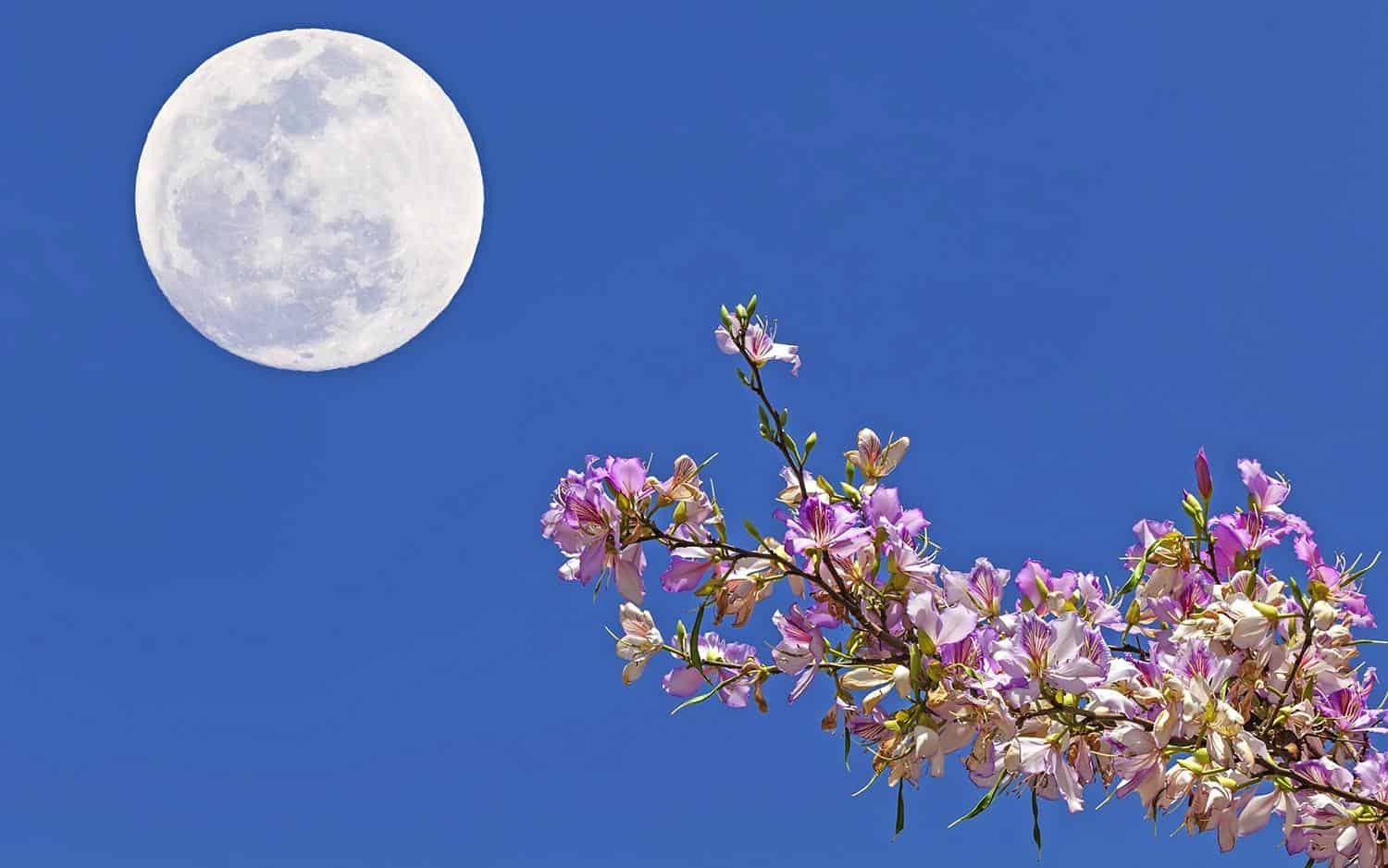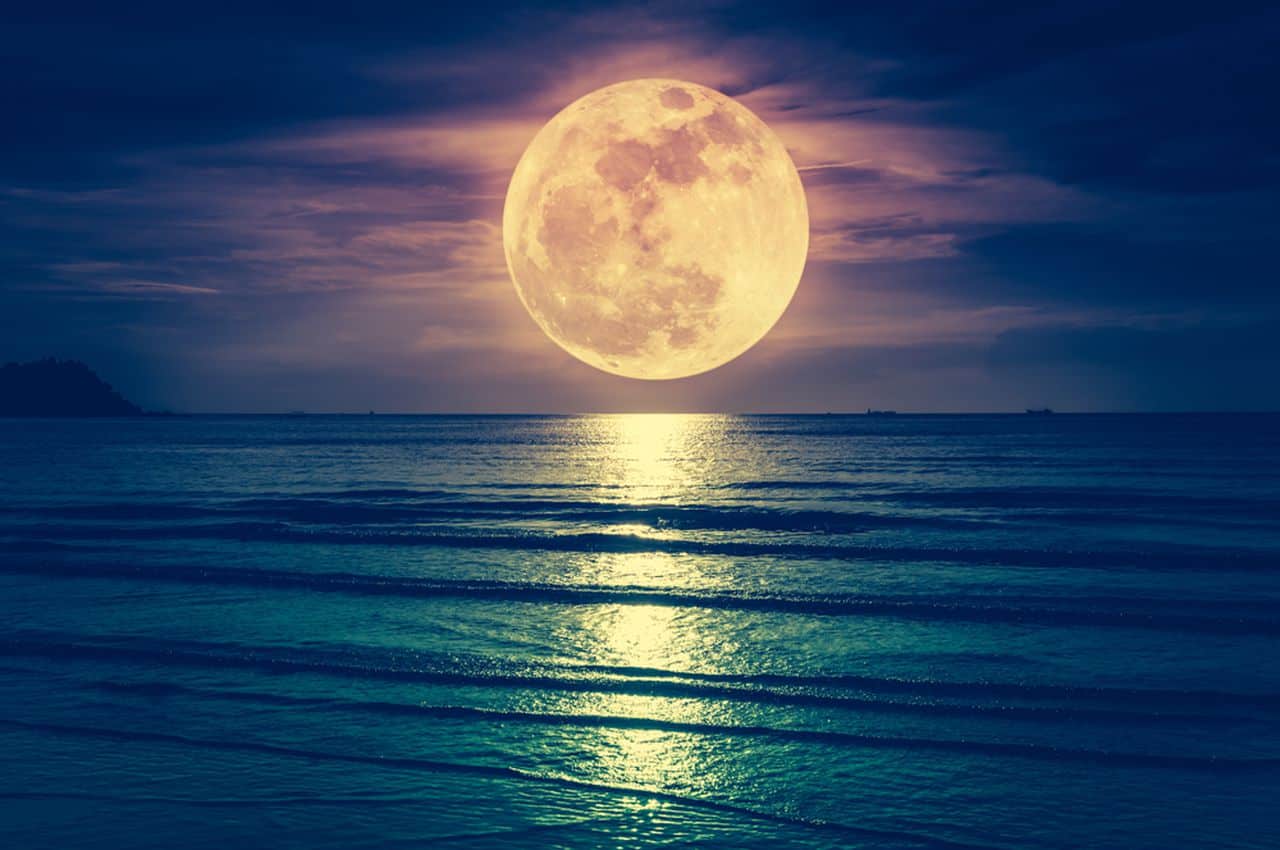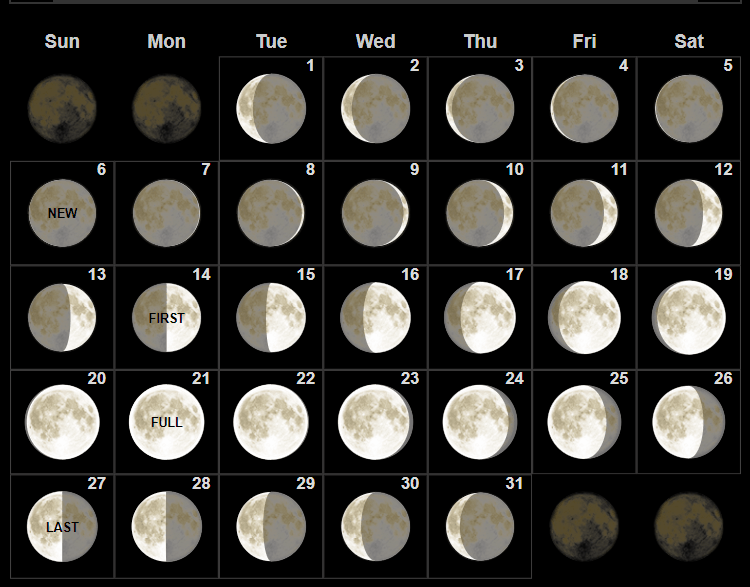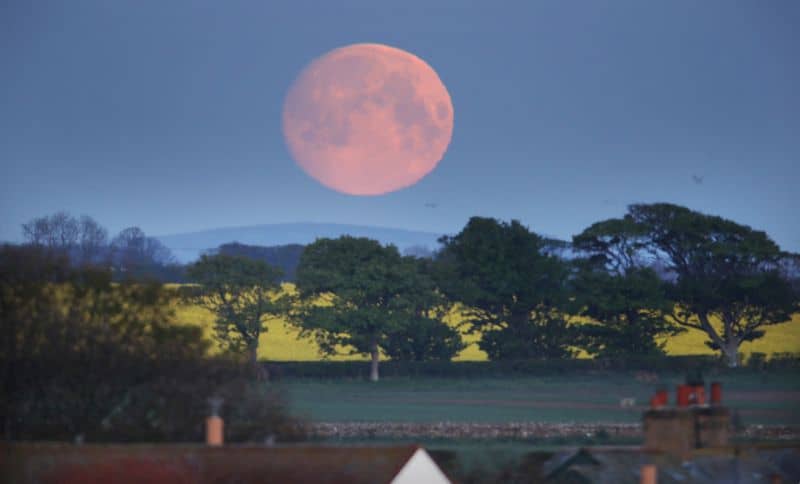May’s Full Moon is generally known as The Flower Moon. The peak of illumination will be reached on May 7, at 6:45 am EDT. It will be the last Supermoon of 2020 so, be sure you don’t miss it.

With that being said, let’s find out where it got its name from, the spiritual meaning of this Full Moon, and its phases.
May’s Full Moon Names
Our modern calendar is based on the solar year. However, our ancestors used the lunar month to keep track of seasons. The names they gave for a full moon applied for the entire lunar month and connected with nature.
The most common name for May’s Full Moon is the Flower Moon. In the Northern Hemisphere, there are so many flowers that bloom in this period.
This is why the Native Americans, the Anglo-Saxons, and Germanic tribes named it this way. They were inspired by how colorful these flowers are, and the wonder of these displays.
Other names for this Full Moon are Corn Plantin Moon, Mother’s Moon, or Milk Moon. The last name was given because cows are milked three times a day at this time of the year.
The Flower Moon Spiritual Meaning
Each Full Moon has its energy. Usually, they come with tension and drama. An uncomfortable battle takes place in our souls, as the Moon and the Sun are on opposite sides. The Moon rules over your subconscious, but the Sun rules over the part of you anybody can see.
This can bring a bit of chaos in our lives, but trust that only good things can happen from this struggle. When you overcome the conflict encouraged by the Full Moon, an impulse of positive change grows in you. Trust this conflict because it will show you what you need to see and know to grow.

This Flower Moon will be intense because it takes place in Scorpio, which is one of the most passionate signs. It can make you feel the need to embrace your darker side. Be sure you know the difference between what you need and what you think you need.
Your imagination may start to go wild at this time but try to stay true to yourself, and this Full Moon will guide you to your highest self. If you have drams or projects you want to resurrect, now it’s the best time because this full Moon will give you the impulse for dramatic change.
Even if this Full Moon may seem scary, and it’s a lot to deal with, it may be the most important thing that happened this year, bringing back to life a part of you that stayed in the shadows of your soul, helping you to embrace it and learn from it.
The Flower Moon’s phases in 2020
On Friday, May 1, the Moon will be in the First Quarter with 58% visibility. The waxing gibbous phase will start on the 2nd and will last until the 5th. The Moon will increase its visibility each night to 95%.
The Full Moon of this month will last three nights, from the 6th until the 8th, with a peak on May 7, with a 100% visibility. After the Full Moon, the Waning phase will begin, the Moon starting to decrease its visibility from 95% on May 9 to 71% on the 12th.

Until the 15th, the Moon will be in the Last Quarter phase, still decreasing its visibility to 42%. The Waning crescent phase will start on the 16th, and it will last until the 20th. On the last night of this phase, visibility will drop to just 5%.
The minimum illumination of the Moon will happen on May 22. It’s the New Moon, which lasts three nights until the 23rd. After this phase, the Moon will enter the Waxing crescent phase for six nights. Its light will slowly increase.
The last night of this phase is the 29th, with the illumination at 43%. On the 30th and the 31st of May, the Moon will enter the First Quarter with the 66% visibility.
What are the Full Moons of 2020?
In 2020 we will have 13 Full Moons, and some of them are Supermoons. Here is the list of when they will occur:
- January 10 – 2:21 pm / 14:21 Wolf Moon Lunar Eclipse
- February 9 – 2:33 am / 02:33 Full Snow Moon
- March 9 – 1:48 pm / 13:48 Super Worm Moon
- April 7 – 10:35 pm / 22:35 Super Pink Moon
- May 7 – 6:45 am / 06:45 Flower Supermoon
- June 5 – 3:12 pm / 15:12 Full Strawberry Moon
- July 5 – 12:44 am / 12:44, Full Buck Moon
- August 3 – 11:59 am / 11:59 Full Sturgeon Moon
- September 2 – 1:22 am / 01:22 Full Corn Moon
- October 1 – 5:05 pm / 17:05 Full Harvest Moon
- October 31 – 9:49 am / 09:49 Full Hunter’s Moon
- November 30 – 4:30 am / 04:30 Full Beaver Moon
- December 29 – 10:28 pm / 22:28 Full Cold Moon
What are the Full Moons of 2021?
In 2021 we will have only 12 Full Moons, and here is when they will occur:
- January 28 – Full Wolf Moon
- February 27 – Full Snow moon
- March 28 – Full worm moon
- April 27 – Full Pink Moon
- May 26 – Full Flower Moon
- June 24 – Full Strawberry Moon
- July 24 – Full Buck Moon
- August 22 – Full Sturgeon Moon
- September 21 – Full Corn moon
- October 20 – Full Hunter’s Moon
- November 19 – Full Beaver Moon
- December 19 – Full Cold Moon
Is May’s Full Moon a Supermoon?
It definitely is a Supermoon. It is the last Supermoon of the year. This year we experienced a series of Spring Supermoons. Even if the Flower Supermoon if a bit less bright and bigger than the March’s and April’s Supermoons, it still qualifies as a Supermoon. The difference is very small.
Usually, the Supermoons appear 7% bigger and 15% brighter. It is hard to notice these differences with bare eyes.
As with every Supermoon or Full Moon, this one will bring stronger weather events and bigger ocean tides. A Supermoon occurs when a Full Moon coincides with the perigee.

Perigee means when the Moon is at its closest point from Earth. When the Moon is at its further point from our planet, it’s called the apogee. This happens because the Moon orbits the Earth in an elliptic motion.
The term Supermoon it’s not defined by International Astronomical Union. Some astronomers consider that this year has four Supermoons, including February’s Full Moon. But many voices disagree, stating that the Snow Full Moon missed the perigee with more than one and a half days. Therefore it’s not entitled to be called a Supermoon.
Did you Know?
- The lunar cycle is 11 days shorter than a solar year. Every few years, lunar calendars add an extra month to keep on track with the seasons.
- The first one who coined the term Supermoon, in 1979 was Richard Nolle. Under his definition, there can be three or four Supermoons in a row in a typical year. If we include February’s Full Moon, 2020 is a year with four Supermoons.
- What we call today a Supermoons once was called a Perigee Full Moon.
- In folklore, the ideal time to accept a marriage proposal or a job recommendation, or any big changes or opportunities in your life is during the Full Moon.
- Another folklore advise is not to wash clothes for the first time during a full moon because they will not last for long.
- The best days in May for planting aboveground crops are the 25th and the 26th. For planting belowground are the 15th and the 16th.
- Recent studies showed that more babies are born during a Full Moon. It’s not known for sure why, but the numbers don’t lie.
- Some sea turtles are using the Full Moon and the bigger tides to lay their eggs.
- Scientists that monitored brain activity during sleep found out it takes longer to fall asleep during a Full Moon, and less brain activity related to deep sleep.
- Prey animals tend to lay low when it’s a full moon because of the light. Predators reduce their huntings also.
- Heart surgery patients recover, on average with four days sooner if they had surgery on or near a full moon, and also, the survival rate is higher.
Sources:
Image Sources:
- https://cdn.mos.cms.futurecdn.net/ekaMh7sFp4Xfk2hGyAZ9KT.jpg
- https://www.almanac.com/sites/default/files/users/AlmanacStaffArchive/flower_moon_0.png
- https://www.nj.com/resizer/DNXuXHqMAl_44WOngj5R05-UW-U=/1280×0/smart/arc-anglerfish-arc2-prod-advancelocal.s3.amazonaws.com/public/H4Y7GD3ZEJEV5BU2RUHQJ74HUM.jpg
- https://i.pinimg.com/originals/d8/87/04/d8870414d144d25a5301a4150d68c574.png
- https://s.yimg.com/ny/api/res/1.2/pyiiOqrbQK8EfhV2nDUBeA–~A/YXBwaWQ9aGlnaGxhbmRlcjtzbT0xO3c9ODAw/https://media-mbst-pub-ue1.s3.amazonaws.com/creatr-images/2020-05/2630a610-8f8b-11ea-b2da-85b1f1b2d26a
